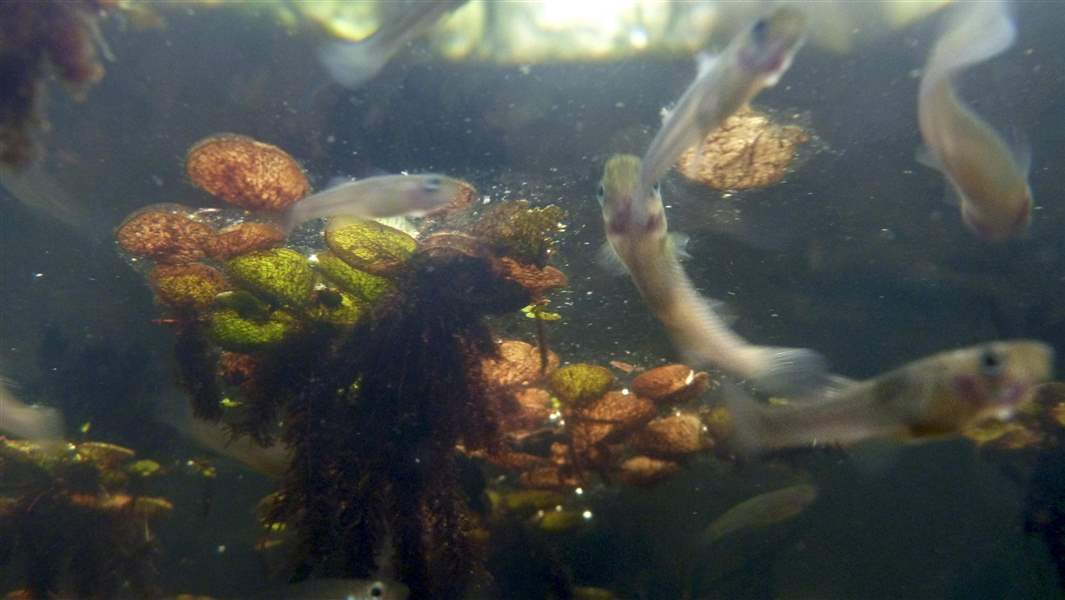
La. marshlands smothered by oil spill may be healing
8/12/2010
Minnows swim in a cypress swamp near Lafitte, La., adjacent to a marsh that stretches to the Gulf of Mexico.
Gerald Herbert / AP
BARATARIA BAY, La. - Shoots of marsh grass and bushes of mangrove trees are starting to grow back in the bay where just months ago photographers shot startling images of dying pelicans coated in oil from the massive Gulf oil spill.
More than a dozen scientists say the marsh here and along the Louisiana coast is healing, giving hope delicate wetlands might weather the worst offshore spill in U.S. history better than feared. Some marsh could be lost, but the amount appears small compared to what the coast loses yearly through development.
Tuesday, a cruise through Barataria Bay's marsh revealed thin shoots growing up out of the oiled mass. Elsewhere, there were gray, dead mangrove shrubs, likely killed by the oil, but even there, new growth was coming up.
"These are areas that were black with oil," said Matt Boasso, a temporary worker with the Louisiana Department of Wildlife and Fisheries.
As crude oil from a blown-out BP well oozed toward the marshes after the April explosion, experts feared it would kill roots in marsh grass, smother mangroves, and dissolve wetlands that plant life held together. State, federal, and BP cleanup efforts focused on preventing that from happening by burning and skimming the oil, blocking it with booms and sand berms, and breaking it up with dispersants. Whether it is a triumph of cleanup work, the marshes' resiliency, or both, scientists have found regrowth of grasses, black mangrove trees, and roseau cane, a lush cane found in the brackish waters at the Mississippi River's mouth.

Minnows swim in a cypress swamp near Lafitte, La., adjacent to a marsh that stretches to the Gulf of Mexico.
"The marsh is coming back, sprigs are popping up," said Alexander S. Kolker, marsh expert and coastal geologist with the Louisiana Universities Marine
Consortium.
With the National Science Foundation, he's looking at the spill's effect on Louisiana's vast marsh - where trappers, shrimpers, and alligator hunters have made their living for generations.
Coastal Louisiana is covered in a thick mat of salt marshes that thrive on the Gulf's edge. The marshes provide life support for fauna and flora in the Gulf, said Bob Thomas, a Loyola University zoologist, and up to 90 percent of commercial fisheries depend on them for some stage of fish development.
Even before the spill, south Louisiana had been losing 25 square miles of marsh a year, a total of 2,300 square miles since the 1930s, mostly from levee construction, logging, shipping, and oil drilling. Only about 5,300 square miles of marsh and swamp remain.
Associated Press calculations indicate that at most, 3.4 square miles of Louisiana marsh were oiled, an area stretched out over hundreds of miles of coast. At least some areas appear to have begun to bounce back.
Ivor van Heerden, a BP-hired environmental scientist, said the damage may be even less. He said federal, state, and BP teams have found only 550 acres of marsh that have been oiled, less than 1 square mile.
The National Oceanic and Atmospheric Administration concurred with Mr. van Heerden's figure but said it and other federal agencies are still calculating just how much marsh was oiled and what the effect has been, agency spokesman Ben Sherman said.
Marsh closest to the Gulf took the worst, absorbing oil and keeping it from oozing farther inland. Even losing a little would be a blow to the ecosystem.
Michael Blum, a Louisiana State University biologist who toured Barataria Bay Tuesday, said some grass won't stick around much longer. "You're seeing exposed roots," he said. "The expectation is that you will have loss of the protective sheet, you have marsh that anchors the marsh in place, and if they die off, they no longer have that anchor."
Many questions remain about how much damage the spill inflicted. Scientists want to understand the effects of the chemical dispersants BP used and look at how the smallest forms of life, things like fiddler crabs and spiders, have been affected.
Irving A. Mendelssohn, a coastal plant ecologist at Louisiana State University, said the wetlands data so far are good news for fishermen who depend on the ecosystem to produce shrimp, menhaden, and other seafood.
"My gut feeling, based on what I have seen, based on the recovery people have observed, I doubt that the impact to the wetlands is going to create a significant problem for our coastal fisheries," Mr. Mendelssohn said.
The news isn't all good, though. U.S. officials have recovered more than 1,000 oil-soaked turtles from the Gulf in recent weeks.
Officials have been tracking the number of oiled turtles recovered since the Deepwater Horizon rig exploded April 20. The oil continued to spew into the Gulf for nearly three months. The number of turtles began to spike in late July.
Of the 1,000 sea turtles recovered since the spill began, 487 were alive and 516 dead, the U.S. Fish and Wildlife Service said. About 570 sea turtles have been found stranded on the coast's beaches, six times the number reported in previous years, said David Mizejewski of the National Wildlife Federation.